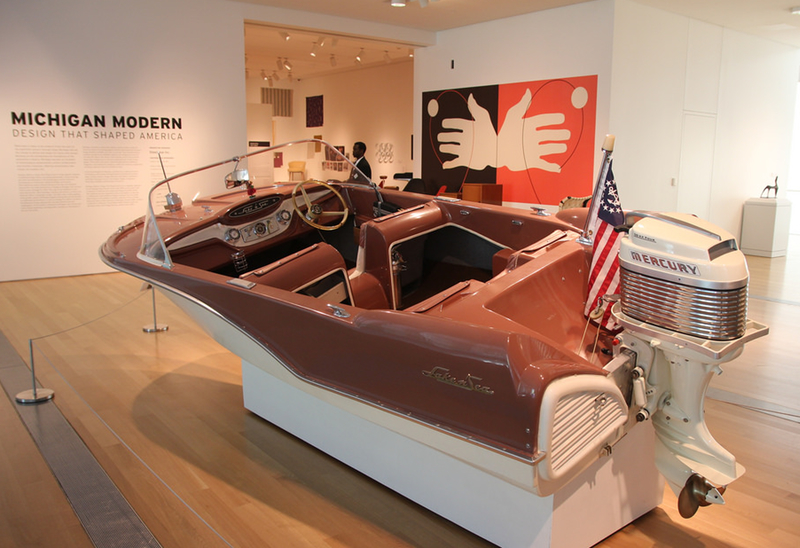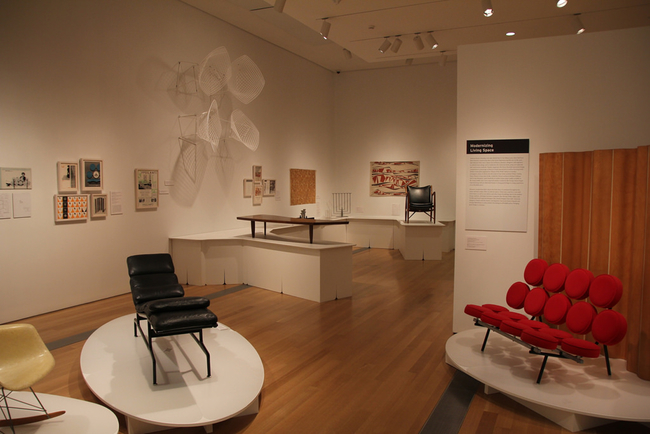In decades past, Michigan produced great design; can it again?
If the past is prologue, then a current exhibition at the Grand Rapids Art Museum, "Michigan Modern: Design that Shaped America," signals great things for the state and offers a road map toward that renewed greatness.
Michigan Modern is an exhibition that celebrates Michigan's "outstanding contributions to Modern design," from the turn of the 20th century through the 1970s. It is an expansion of an exhibition that debuted last summer at Cranbrook, and runs at GRAM until Aug. 24.
The exhibition includes contributions from the automotive, furniture, architecture, boating and outdoor recreation design worlds, and shows how, in each of these areas, Michigan made unique contributions. As the opening panel at the exhibition describes, during this period, "Michigan became an incubator of technological advancement, artistic achievement, and stylish invention, offering revolutionary new visions for modern life." This was a design movement that brought together both those who had grown up in Michigan and those from afar who wanted to be part of the ferment that was going on here in these years.
In the last month, I've been able to tour the exhibit twice, sit in on a Q&A and interview, via e-mail, GRAM director and CEO Dana Friis-Hansen and Amy Arnold of the Michigan State Historic Preservation Office. Viewing the exhibit and hearing about its background suggests ways the Michigan might find ways to contribute on a global scale like this again.
The impetus behind the exhibition, according to Arnold, was a grant that led the SHPO to begin documenting Michigan's design contribution. The SHPO "quickly realized that Michigan’s contribution to modernism was early, very significant, under-documented and not well known." The SHPO "was interested in helping to change Michigan’s image as a rust belt manufacturing state." As Arnold told me, design "has been equally important, if not more, to the state’s economy."
In fact, "Michigan was a design powerhouse after World War II" and many of the "products and people that made (Los Angeles) famous for modernism in the 1950s and 1960s came out of Michigan."
Touring the exhibition, one sees those precedents and the parallels between Michigan's design contributions and today's design. For instance, as I observed the sleek, minimalist furniture West Michigan contributed, I couldn’t help but think of the iPhone in my pocket. Highlights of my visits included the cutaway Model T, the photos and models of Albert Kahn's innovative industrial plant design, and the model living room from the Mies van der Rohe-designed Lafayette Park in Detroit. The Model T is particularly impressive in its simplicity and beauty. I found myself impressed by how something so simple could have revolutionized our world in so many ways—for good and ill.
New to "Michigan Modern" at GRAM is a portion on recreational, outdoor design, including boats. Friis-Hansen said that these watercraft are exciting pieces because boat making is "a field of beauty and innovation that is underappreciated, and we can underscore the ways that mathematics and design, materials science, and styling came together in beautiful and powerful ways." The three boats on display truly are pieces of works of beauty, and I was impressed by the craftsmanship and artistry that went into their creation.
We can take a number of lessons from the exhibition as well. The first is a cautionary tale.
While the exhibition's focus from the early 20th century through the 1970s is a function of the Modernism being highlighted, it also shows what can happen when creativity and beauty take a back seat to practical concerns. As Arnold noted, in the 1970s, the "car companies lost their interest in design and quality" and "manufacturing focus changed from being driven by design creativity to cost effectiveness."
In other words, beauty and form took a backseat to functionality. Apple's success in the last decade and half demonstrates that beauty and functionality need not be at cross-purposes. As Michigan attempts to launch itself back into the national and global conversation, the drop-off for Michigan design in the 1970s teaches us that beauty should never become optional.
Another lesson we can learn is what it takes to make Michigan an incubator for design and other industries in the future. I asked both Friis-Hansen and Arnold what made the state so special during the period highlighted by “Michigan Modern.” According to Arnold, "Michigan had the wealth and means to undertake projects. Michigan companies supported modernism because it was viewed as forward thinking and they wanted to define themselves as cutting edge." Moreover, the creators and artists were appreciated.
Friis-Hansen said that these creators were invited to do their best work, rewarded for it, and because of that, stayed. As Michigan thinks about how to bring young creatives back or to keep them here, it is important to think through these lessons. Quality and creativity thrive in a critical mass of interesting people being brought together and being pushed to do their best work. Whether it be in downtown Detroit or Grand Rapids, our political, business and community leaders need to find ways to reward risk and excellence and to make spaces and room for the sort of collaboration that made Michigan such a powerful design force in the 20th Century.
The lessons of "Michigan Modern" transcend design and show a way forward for Michigan's efforts in many different areas.
See what new members are saying about why they donated to Bridge Michigan:
- “In order for this information to be accurate and unbiased it must be underwritten by its readers, not by special interests.” - Larry S.
- “Not many other media sources report on the topics Bridge does.” - Susan B.
- “Your journalism is outstanding and rare these days.” - Mark S.
If you want to ensure the future of nonpartisan, nonprofit Michigan journalism, please become a member today. You, too, will be asked why you donated and maybe we'll feature your quote next time!


 The dashing lines of a midcentury speedboat show how Michigan’s manufacturing community once was known for its great product design. An exhibit at the Grand Rapids Art Museum showcases “Michigan Modern.” (Photo courtesy of GRAM)
The dashing lines of a midcentury speedboat show how Michigan’s manufacturing community once was known for its great product design. An exhibit at the Grand Rapids Art Museum showcases “Michigan Modern.” (Photo courtesy of GRAM) When it comes to midcentury furniture design, no company stood as tall as Herman Miller, whose designers were known for such triumphs as the “marshmallow sofa,” rendered here in bright red. (Photo courtesy of GRAM)
When it comes to midcentury furniture design, no company stood as tall as Herman Miller, whose designers were known for such triumphs as the “marshmallow sofa,” rendered here in bright red. (Photo courtesy of GRAM)